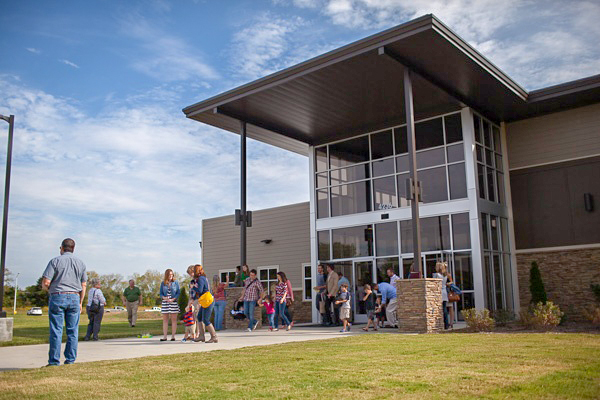Dow Smith Company is building a new facility for Precision Internal Medical in Smyrna, Tennessee.
As businesses expand and evolve, the question of physical space inevitably arises. For many growing companies, the immediate thought might be to lease a larger existing property or renovate their current one. However, a compelling argument can be made for the strategic decision to build a new ground-up facility. This approach, while seemingly more daunting, offers unparalleled advantages in terms of customization, operational efficiency, future-proofing, financial benefits, and competitive advantage, ultimately providing a solid foundation for sustained growth and success.
Unmatched Customization and Design Control
One of the most significant benefits of ground-up construction is the ability to design a facility that perfectly aligns with a business's unique needs and operational workflows. Unlike existing structures that often require compromises and costly retrofits, a new build allows for complete control over every aspect of the design, from the layout and infrastructure to specialized equipment integration. This bespoke approach ensures that the facility is optimized for maximum productivity and efficiency from day one. For instance, a manufacturing company can design a production line that minimizes material handling and maximizes throughput, or a tech company can create an office space that fosters collaboration and innovation with specific departmental adjacencies and technology infrastructure built-in. This level of tailored design is virtually impossible to achieve with an existing building, where the inherent limitations of the structure often dictate the possibilities.
Enhanced Operational Efficiency
Building on the theme of customization, a ground-up facility directly translates into enhanced operational efficiency. By designing the space around specific processes, businesses can eliminate bottlenecks, reduce wasted movement, and streamline workflows. This can lead to significant cost savings in the long run through reduced labor, energy consumption, and maintenance. For example, a distribution center can be designed with optimal loading dock configurations, warehouse racking systems, and material flow paths to expedite shipping and receiving. Similarly, a healthcare facility can be laid out to improve patient flow and staff efficiency, leading to better patient outcomes and reduced wait times. The ability to integrate advanced technologies, such as automation and smart building systems, from the ground up further amplifies operational efficiency, providing real-time data and control over various aspects of the facility.
Future-Proofing for Long-Term Growth
A new ground-up facility offers an invaluable opportunity to future-proof a business against evolving market demands and technological advancements. When designing a new building, businesses can incorporate flexibility and scalability into the plans, anticipating future expansion or changes in operational needs. This might include designing for modular expansion, incorporating adaptable spaces, or installing infrastructure that can support future technological upgrades. For example, a data center can be built with expandable power and cooling systems to accommodate increased server capacity, or a research and development lab can be designed with adaptable lab benches and utility connections to support diverse research projects. This foresight minimizes the need for disruptive and expensive renovations down the line, allowing the business to adapt and grow seamlessly without being constrained by its physical space. This long-term perspective is crucial for businesses with ambitious growth trajectories, as it ensures that their physical infrastructure can keep pace with their strategic objectives.
Financial Advantages and Asset Appreciation
While the initial investment in a ground-up facility might seem substantial, there are significant financial advantages to consider, particularly when compared to long-term leasing. Owning a commercial property allows a business to build equity, which can appreciate over time and become a valuable asset on the balance sheet. This appreciation can provide a significant return on investment and serve as collateral for future financing. Furthermore, businesses can often benefit from tax deductions related to depreciation, interest payments, and property taxes. Unlike leasing, where rent payments offer no long-term asset accumulation, owning a facility transforms a recurring expense into an investment. This financial stability and potential for asset appreciation can be a powerful driver for long-term financial health and growth.
Competitive Advantage and Brand Identity
Finally, a custom-built facility can provide a significant competitive advantage and reinforce a business's brand identity. A well-designed, modern facility can attract top talent, impress clients, and enhance the company's reputation. It serves as a tangible representation of the company's values, professionalism, and commitment to excellence. For example, a cutting-edge facility can showcase a company's innovation and technological prowess, while a thoughtfully designed office space can reflect a company's culture and commitment to employee well-being. This physical manifestation of the brand can differentiate a business in a crowded marketplace, fostering trust and confidence among stakeholders. Moreover, having a facility specifically designed for optimal operations can lead to superior product quality, faster delivery times, and improved customer service, all of which contribute to a stronger competitive position.
While the decision to build a new ground-up facility requires careful planning and a significant investment, the long-term benefits far outweigh the challenges. The unparalleled customization, enhanced operational efficiency, future-proofing capabilities, financial advantages, and competitive edge gained from a purpose-built space provide a robust foundation for growing businesses to thrive and achieve their full potential. It is an investment not just in bricks and mortar, but in the sustained success and strategic positioning of the enterprise.




